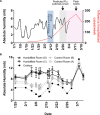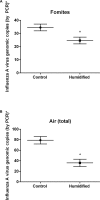Humidity as a non-pharmaceutical intervention for influenza A
- PMID: 30252890
- PMCID: PMC6155525
- DOI: 10.1371/journal.pone.0204337
Humidity as a non-pharmaceutical intervention for influenza A
Abstract
Influenza is a global problem infecting 5-10% of adults and 20-30% of children annually. Non-pharmaceutical interventions (NPIs) are attractive approaches to complement vaccination in the prevention and reduction of influenza. Strong cyclical reduction of absolute humidity has been associated with influenza outbreaks in temperate climates. This study tested the hypothesis that raising absolute humidity above seasonal lows would impact influenza virus survival and transmission in a key source of influenza virus distribution, a community school. Air samples and objects handled by students (e.g. blocks and markers) were collected from preschool classrooms. All samples were processed and PCR used to determine the presence of influenza virus and its amount. Additionally samples were tested for their ability to infect cells in cultures. We observed a significant reduction (p < 0.05) in the total number of influenza A virus positive samples (air and fomite) and viral genome copies upon humidification as compared to control rooms. This suggests the future potential of artificial humidification as a possible strategy to control influenza outbreaks in temperate climates. There were 2.3 times as many ILI cases in the control rooms compared to the humidified rooms, and whether there is a causal relationship, and its direction between the number of cases and levels of influenza virus in the rooms is not known. Additional research is required, but this is the first prospective study suggesting that exogenous humidification could serve as a scalable NPI for influenza or other viral outbreaks.
Conflict of interest statement
Phil Lilja is employed by DriSteem, a manufacturer of commercial humidification equipment. This does not alter our adherence to PLOS ONE policies on sharing data and materials.
Figures



Similar articles
-
Associative evidence for the potential of humidification as a non-pharmaceutical intervention for influenza and SARS-CoV-2 transmission.J Expo Sci Environ Epidemiol. 2022 Sep;32(5):720-726. doi: 10.1038/s41370-022-00472-3. Epub 2022 Sep 14. J Expo Sci Environ Epidemiol. 2022. PMID: 36104526 Free PMC article.
-
Predictors of indoor absolute humidity and estimated effects on influenza virus survival in grade schools.BMC Infect Dis. 2013 Feb 5;13:71. doi: 10.1186/1471-2334-13-71. BMC Infect Dis. 2013. PMID: 23383620 Free PMC article.
-
Environmental role in influenza virus outbreaks.Annu Rev Anim Biosci. 2015;3:347-73. doi: 10.1146/annurev-animal-022114-111017. Epub 2014 Nov 12. Annu Rev Anim Biosci. 2015. PMID: 25422855 Review.
-
Seasonality of absolute humidity explains seasonality of influenza-like illness in Vietnam.Epidemics. 2015 Dec;13:65-73. doi: 10.1016/j.epidem.2015.06.002. Epub 2015 Aug 28. Epidemics. 2015. PMID: 26616043
-
Influenza and humidity--Why a bit more damp may be good for you!J Infect. 2015 Jun;71 Suppl 1:S54-8. doi: 10.1016/j.jinf.2015.04.013. Epub 2015 Apr 25. J Infect. 2015. PMID: 25917802 Review.
Cited by
-
Viruses in the Built Environment (VIBE) meeting report.Microbiome. 2020 Jan 4;8(1):1. doi: 10.1186/s40168-019-0777-4. Microbiome. 2020. PMID: 31901242 Free PMC article.
-
Nonpharmaceutical Measures for Pandemic Influenza in Nonhealthcare Settings-Personal Protective and Environmental Measures.Emerg Infect Dis. 2020 May;26(5):967-975. doi: 10.3201/eid2605.190994. Epub 2020 May 17. Emerg Infect Dis. 2020. PMID: 32027586 Free PMC article. Review.
-
Can Prophylactic High Flow of Humidified and Warmed Filtered Air Improve Survival from Bacterial Pneumonia and SARS-CoV-2 in Elderly Individuals? The Role of Surfactant Protein A.Antioxidants (Basel). 2021 Apr 22;10(5):640. doi: 10.3390/antiox10050640. Antioxidants (Basel). 2021. PMID: 33922049 Free PMC article.
-
High Prevalence of Viral Infections Among Hospitalized Pneumonia Patients in Equatorial Sarawak, Malaysia.Open Forum Infect Dis. 2019 Feb 13;6(3):ofz074. doi: 10.1093/ofid/ofz074. eCollection 2019 Mar. Open Forum Infect Dis. 2019. PMID: 30949525 Free PMC article.
-
Unanswered questions on the airborne transmission of COVID-19.Environ Chem Lett. 2023;21(2):725-739. doi: 10.1007/s10311-022-01557-z. Epub 2023 Jan 6. Environ Chem Lett. 2023. PMID: 36628267 Free PMC article. Review.
References
-
- WHO. Influenza (Seasonal) Fact Sheet N°211. 2014. [updated March 2014; cited 2015 October 15]. Available from: http://www.who.int/mediacentre/factsheets/fs211/en/.
-
- Minnesota Department of Health Weekly Influenza & Respiratory Illness Activity Report- Summary of 2014–15 Influenza Season. 2015. [updated October 6, 2016; cited 2015 September 10]. Available from: http://www.health.state.mn.us/divs/idepc/diseases/flu/stats/2014summary.pdf.
Publication types
MeSH terms
Grants and funding
LinkOut - more resources
Full Text Sources
Other Literature Sources
Medical

